Microsoft 70-761 Exam Practice Questions (P. 3)
- Full Access (201 questions)
- One Year of Premium Access
- Access to one million comments
- Seamless ChatGPT Integration
- Ability to download PDF files
- Anki Flashcard files for revision
- No Captcha & No AdSense
- Advanced Exam Configuration
Question #11
HOTSPOT -
Note: This question is part of a series of questions that use the same scenario. For your convenience, the scenario is repeated in each question. Each question presents a different goal and answer choices, but the text of the scenario is exactly the same in each question in this series.
You query a database that includes two tables: Project and Task. The Project table includes the following columns:


You need to identify the owner of each task by using the following rules:
✑ Return each task's owner if the task has an owner.
✑ If a task has no owner, but is associated with a project that has an owner, return the project's owner.
✑ Return the value-1for all other cases.
How should you complete the Transact-SQL statement? To answer, select the appropriate Transact-SQL segments in the answer area.
Hot Area:
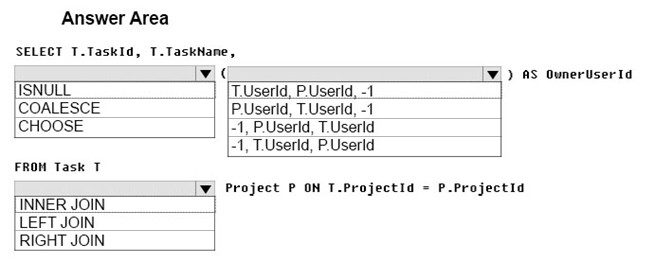
Note: This question is part of a series of questions that use the same scenario. For your convenience, the scenario is repeated in each question. Each question presents a different goal and answer choices, but the text of the scenario is exactly the same in each question in this series.
You query a database that includes two tables: Project and Task. The Project table includes the following columns:


You need to identify the owner of each task by using the following rules:
✑ Return each task's owner if the task has an owner.
✑ If a task has no owner, but is associated with a project that has an owner, return the project's owner.
✑ Return the value-1for all other cases.
How should you complete the Transact-SQL statement? To answer, select the appropriate Transact-SQL segments in the answer area.
Hot Area:

Correct Answer:
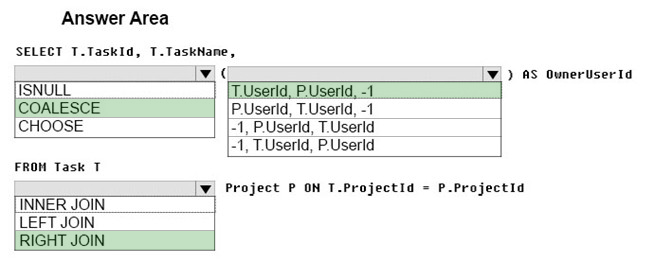
Box 1: COALESCE -
COALESCE evaluates the arguments in order and returns the current value of the first expression that initially does not evaluate to NULL.
Box 2: T.UserID, p.UserID, -1 -
✑ Return each task's owner if the task has an owner.
✑ If a task has no owner, but is associated with a project that has an owner, return the project's owner.
✑ Return the value -1 for all other cases.
Box 3: RIGHT JOIN -
The RIGHT JOIN keyword returns all rows from the right table (table2), with the matching rows in the left table (table1). The result is NULL in the left side when there is no match. Here the right side could be NULL as the projectID of the task could be NULL.
References:
https://msdn.microsoft.com/en-us/library/ms190349.aspx
http://www.w3schools.com/Sql/sql_join_right.asp

Box 1: COALESCE -
COALESCE evaluates the arguments in order and returns the current value of the first expression that initially does not evaluate to NULL.
Box 2: T.UserID, p.UserID, -1 -
✑ Return each task's owner if the task has an owner.
✑ If a task has no owner, but is associated with a project that has an owner, return the project's owner.
✑ Return the value -1 for all other cases.
Box 3: RIGHT JOIN -
The RIGHT JOIN keyword returns all rows from the right table (table2), with the matching rows in the left table (table1). The result is NULL in the left side when there is no match. Here the right side could be NULL as the projectID of the task could be NULL.
References:
https://msdn.microsoft.com/en-us/library/ms190349.aspx
http://www.w3schools.com/Sql/sql_join_right.asp
send
light_mode
delete
Question #12
DRAG DROP -
Note: This question is part of a series of questions that use the same scenario. For your convenience, the scenario is repeated in each question. Each question presents a different goal and answer choices, but the text of the scenario is exactly the same in each question in this series.
You query a database that includes two tables: Project and Task. The Project table includes the following columns:


Task level is defined using the following rules:

You need to determine the task level for each task in the hierarchy.
Which five Transact-SQL segments should you use to develop the solution? To answer, move the appropriate Transact-SQL segments from the list of Transact-
SQL segments to the answer area and arrange them in the correct order.
Select and Place:
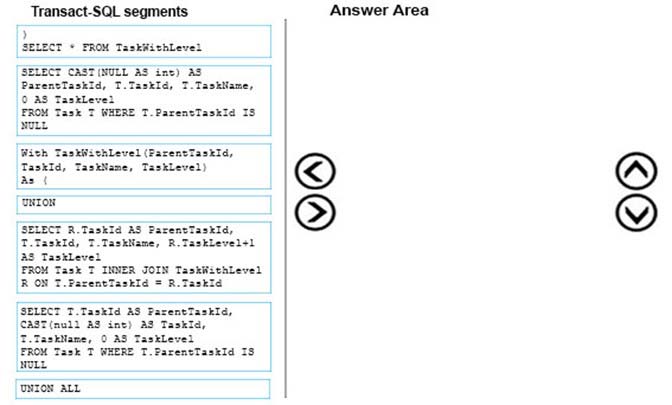
Note: This question is part of a series of questions that use the same scenario. For your convenience, the scenario is repeated in each question. Each question presents a different goal and answer choices, but the text of the scenario is exactly the same in each question in this series.
You query a database that includes two tables: Project and Task. The Project table includes the following columns:


Task level is defined using the following rules:

You need to determine the task level for each task in the hierarchy.
Which five Transact-SQL segments should you use to develop the solution? To answer, move the appropriate Transact-SQL segments from the list of Transact-
SQL segments to the answer area and arrange them in the correct order.
Select and Place:

Correct Answer:
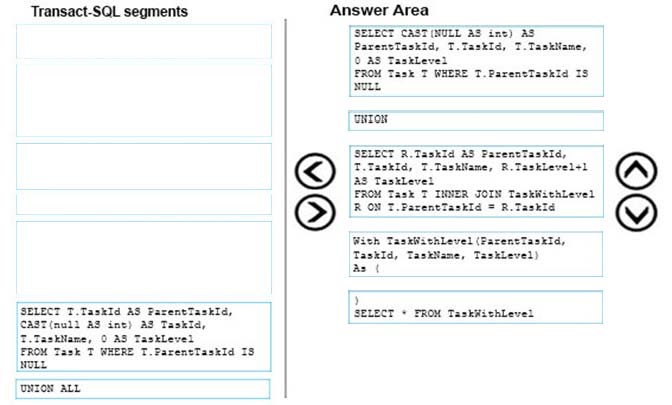
Box 1: SELECT CAST (NULL AS INT) AS ParentTaskID, etc.
This statement selects all tasks with task level 0.
The ParentTaskID could be null so we should use CAST (NULL AS INT) AS ParentTaskID.
Box 2: UNION -
We should use UNION and not UNION ALL as we do not went duplicate rows.
UNION specifies that multiple result sets are to be combined and returned as a single result set.
Incorrect Answers:
Not UNION ALL: ALL incorporates all rows into the results. This includes duplicates. If not specified, duplicate rows are removed.
Box 3, Box 4, Box 5:
These statements select all tasks with task level >0.
References:
https://msdn.microsoft.com/en-us/library/ms180026.aspx

Box 1: SELECT CAST (NULL AS INT) AS ParentTaskID, etc.
This statement selects all tasks with task level 0.
The ParentTaskID could be null so we should use CAST (NULL AS INT) AS ParentTaskID.
Box 2: UNION -
We should use UNION and not UNION ALL as we do not went duplicate rows.
UNION specifies that multiple result sets are to be combined and returned as a single result set.
Incorrect Answers:
Not UNION ALL: ALL incorporates all rows into the results. This includes duplicates. If not specified, duplicate rows are removed.
Box 3, Box 4, Box 5:
These statements select all tasks with task level >0.
References:
https://msdn.microsoft.com/en-us/library/ms180026.aspx
send
light_mode
delete
Question #13
DRAG DROP -
Note: This question is part of a series of questions that use the same scenario. For your convenience, the scenario is repeated in each question. Each question presents a different goal and answer choices, but the text of the scenario is exactly the same in each question in this series.
You query a database that includes two tables: Project and Task. The Project table includes the following columns:


When running an operation, you updated a column named EndTime for several records in the Project table, but updates to the corresponding task records in the
Task table failed.
You need to synchronize the value of the EndTime column in the Task table with the value of the EndTime column in the project table. The solution must meet the following requirements:
✑ If the EndTime column has a value, make no changes to the record.
✑ If the value of the EndTime column is null and the corresponding project record is marked as completed, update the record with the project finish time.
Which four Transact-SQL segments should you use to develop the solution? To answer, move the appropriate Transact-SQL segments from the list of Transact-
SQL segments to the answer area and arrange them in the correct order.
Select and Place:
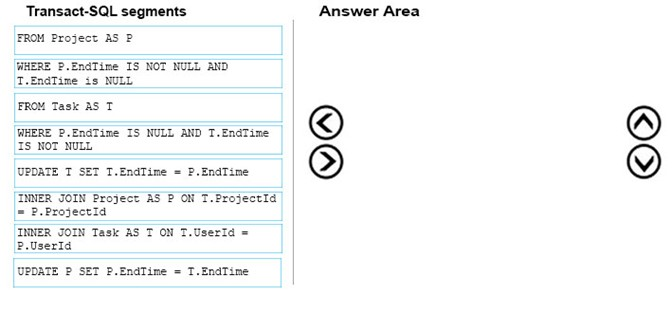
Note: This question is part of a series of questions that use the same scenario. For your convenience, the scenario is repeated in each question. Each question presents a different goal and answer choices, but the text of the scenario is exactly the same in each question in this series.
You query a database that includes two tables: Project and Task. The Project table includes the following columns:


When running an operation, you updated a column named EndTime for several records in the Project table, but updates to the corresponding task records in the
Task table failed.
You need to synchronize the value of the EndTime column in the Task table with the value of the EndTime column in the project table. The solution must meet the following requirements:
✑ If the EndTime column has a value, make no changes to the record.
✑ If the value of the EndTime column is null and the corresponding project record is marked as completed, update the record with the project finish time.
Which four Transact-SQL segments should you use to develop the solution? To answer, move the appropriate Transact-SQL segments from the list of Transact-
SQL segments to the answer area and arrange them in the correct order.
Select and Place:

Correct Answer:
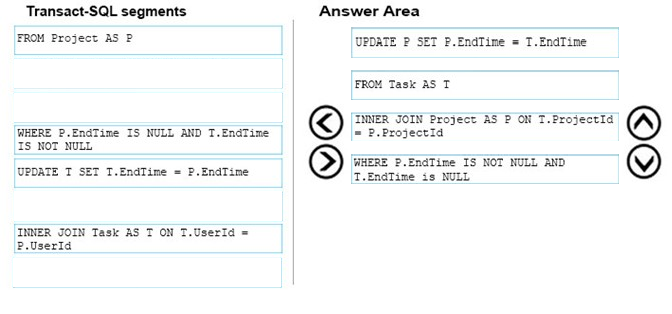
Box 1: UPDATE T SET T.EndTime = P.EndTime
We are updating the EndTime column in the Task table.
Box 2: FROM Task AS T -
Where are updating the task table.
Box 3:INNER JOIN Project AS P on T.ProjectID = P.ProjectID
We join with the Project table (on the ProjectID columnID column).
Box 4: WHERE P.EndTime is NOT NULL AND T.EndTime is NULL
We select the columns in the Task Table where the EndTime column in the Project table has a value (NOT NULL),but where it is NULL in the Task Table.
References:
https://msdn.microsoft.com/en-us/library/ms177523.aspx

Box 1: UPDATE T SET T.EndTime = P.EndTime
We are updating the EndTime column in the Task table.
Box 2: FROM Task AS T -
Where are updating the task table.
Box 3:INNER JOIN Project AS P on T.ProjectID = P.ProjectID
We join with the Project table (on the ProjectID columnID column).
Box 4: WHERE P.EndTime is NOT NULL AND T.EndTime is NULL
We select the columns in the Task Table where the EndTime column in the Project table has a value (NOT NULL),but where it is NULL in the Task Table.
References:
https://msdn.microsoft.com/en-us/library/ms177523.aspx
send
light_mode
delete
Question #14
You need to create a database object that meets the following requirements:
✑ accepts a product identified as input
✑ calculates the total quantity of a specific product, including quantity on hand and quantity on order
✑ caches and reuses execution plan
✑ returns a value
✑ can be called from within a SELECT statement
✑ can be used in a JOIN clause
What should you create?
✑ accepts a product identified as input
✑ calculates the total quantity of a specific product, including quantity on hand and quantity on order
✑ caches and reuses execution plan
✑ returns a value
✑ can be called from within a SELECT statement
✑ can be used in a JOIN clause
What should you create?
- Aan extended stored procedure
- Ba user-defined scalar function
- Ca user-defined stored procedure that has an OUTPUT parameter
- Da temporary table that has a columnstore index
Correct Answer:
B
User-defined scalar functions are execution plans that accept parameters, perform an action such as a complex calculation, and returns the result of that action as a value. The return value can either be a single scalar value or a result set. Furthermore the execution plan is cached and reusable.
User-defined scalar functions can also be called from within a SELECT statement and can be used in a JOIN clause.
Incorrect Answers:
A: Using extended stored procedures is not recommended as they has been deprecated. CLR Integration should be used instead of extended stored procedures.
C: Stored procedures cannot be used in a SELECT statement or in a JOIN clause.
D: A temporary table is a result set and not a value.
References:
https://www.c-sharpcorner.com/UploadFile/996353/difference-between-stored-procedure-and-user-defined-functio/
B
User-defined scalar functions are execution plans that accept parameters, perform an action such as a complex calculation, and returns the result of that action as a value. The return value can either be a single scalar value or a result set. Furthermore the execution plan is cached and reusable.
User-defined scalar functions can also be called from within a SELECT statement and can be used in a JOIN clause.
Incorrect Answers:
A: Using extended stored procedures is not recommended as they has been deprecated. CLR Integration should be used instead of extended stored procedures.
C: Stored procedures cannot be used in a SELECT statement or in a JOIN clause.
D: A temporary table is a result set and not a value.
References:
https://www.c-sharpcorner.com/UploadFile/996353/difference-between-stored-procedure-and-user-defined-functio/
send
light_mode
delete
Question #15
HOTSPOT -
You have the following stored procedure:
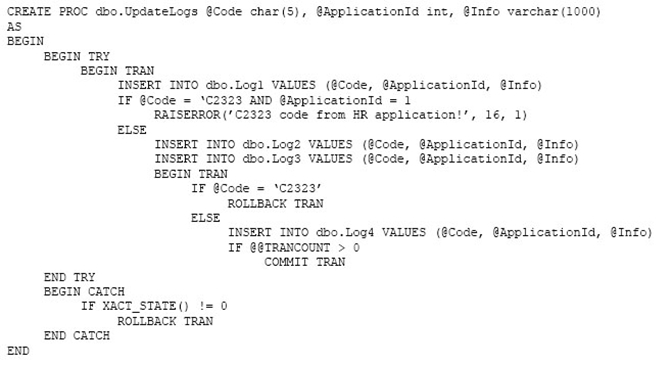
You run the following Transact-SQL statements:

What is the result of each Transact-SQL statement? To answer, select the appropriate options in the answer area.
Hot Area:
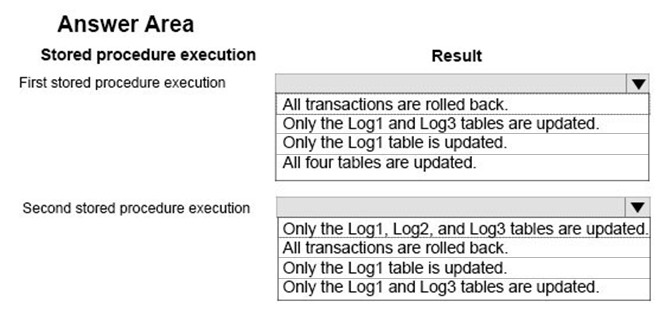
You have the following stored procedure:

You run the following Transact-SQL statements:

What is the result of each Transact-SQL statement? To answer, select the appropriate options in the answer area.
Hot Area:

Correct Answer:
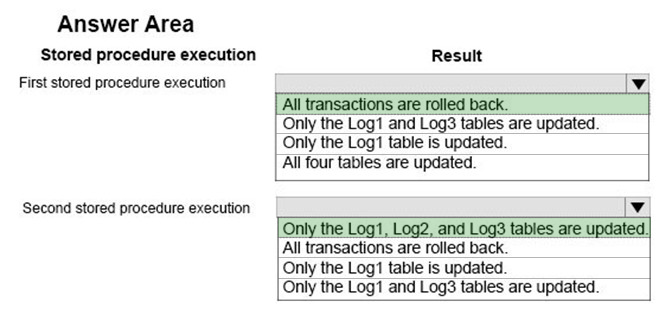
Box 1: All transactions are rolled back.
The first IF-statement, IF @CODE = 'C2323' AND @ApplicationID = 1, will be true, an error will be raised, the error will be caught in the CATCH block, and the only transaction that has been started will be rolled back.
Box 2: Only Log1, Log2, and Log3 tables are updated.
The second IF-statement, IF @Code = 'C2323', will be true, so the second transaction will be rolled back, but log1, log2, and log3 was updated before the second transaction.

Box 1: All transactions are rolled back.
The first IF-statement, IF @CODE = 'C2323' AND @ApplicationID = 1, will be true, an error will be raised, the error will be caught in the CATCH block, and the only transaction that has been started will be rolled back.
Box 2: Only Log1, Log2, and Log3 tables are updated.
The second IF-statement, IF @Code = 'C2323', will be true, so the second transaction will be rolled back, but log1, log2, and log3 was updated before the second transaction.
send
light_mode
delete
All Pages
